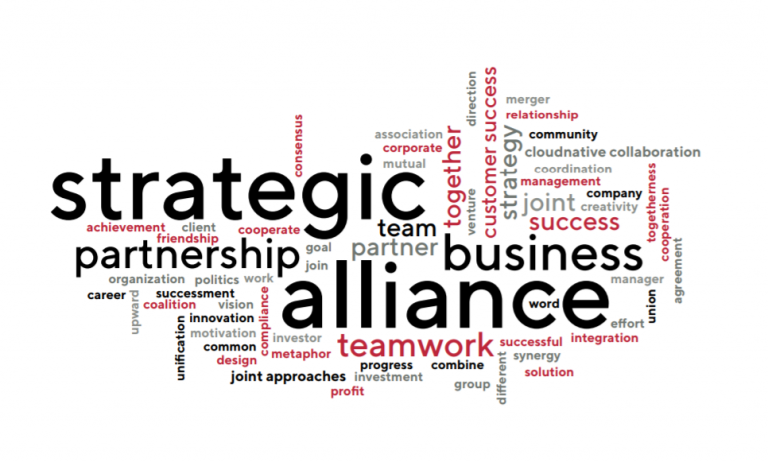A complex and powerful step towards success
Modern organizations and companies are increasingly working in partnership with other companies. This article examines what forms of corporate partnerships or strategic alliances there are and why this form of collaboration is becoming increasingly important, especially in the cloud environment.
In the fast-moving world of cloud technology business, partnership announcements are a firm component of the daily news stream. On the surface, all these carefully crafted press releases seem to indicate a sustained integration of market players. On closer examination however, you’ll find that many conveniently coined “partnerships” or “strategic partnerships” are in fact sales agreements. Everybody wants to make money; hence a reseller partner sells a given product. Even though expanding the channel organizations across different regions or serving a variety of customers may well support strategic business objectives, both modes of cooperation are straight-forward and may not deserve puffing terminology. In fact, the ubiquitous use of it should make us wonder what Partnership or Strategic Alliance could really be and what can be gained from it, for cloud businesses and clients alike.

To be upfront about it, there are various contexts and cases in which Global Strategic Alliances create an impact far beyond distribution agreements. We all work in an increasingly complex technology ecosystem that is confronted with an endless sophistication of customer requirements and expectations. One dimensional cooperation alone will not be enough for a company to survive, or even grow it´s revenue in the future. Successful players in the cloud arena must adopt more sophisticated modes of collaboration that allow solving of most complex challenges. A big hand for Strategic Alliances!
Laurel Delany states that Global Strategic Alliance means „joining forces with another company of similar size and market presence that is located in a foreign country where you are already doing business or would like to.”(1) That seems rather narrow. Is it really the similarity in company size that makes an alliance global, strategic and successful? And does it necessarily need to be business in a foreign country, only because it is „global“? And why can it be important for modern tech-companies to join forces at all?
Joining forces with another company to close gaps
Delany gives the reader a more classical view on Global Strategic Alliances, when writing:
A global strategic alliance is usually established when a company wishes to edge into a related business or new geographic market, particularly one where the government prohibits imports in order to protect domestic industry. Alliances are typically formed between two or more corporations, each based in their home country, for a specified period of time. Their purpose is to share in the ownership of a newly formed venture and maximize competitive advantages in their combined territories.(2)
But Global Strategic Alliances is way more than that, and way more complex. A Global Strategic Alliance should usually be established when two companies find a deficit in any area of their organization or work. This could be in any part of their business, i.e. in a strategic way or based on a lack of knowledge or expertise in a different area, or of course in a different geographical market. However, it can be in the same geographical market; just think of two smaller companies forming an alliance to have a better standing against a big, dominating competitor.
This is especially true for tech-companies. The IT world has become much more complex and diverse during the last decade. Release cycles, updates, new technologies etc. changed at an increasing speed and evolved into ever more specializations. (In this regard, IT seems not much different from science.) No single organization can effectively manage this dual challenge of speed and specialization. A good example is the whole Kubernetes ecosystem. It came up five years ago and the first KubeCon CloudnativeCon, held by the CNCF(3) in November 2015, had less than 1.000 participants. Now, the numbers go up to 8.000 for the US conference and there are more than 2.66 million contributions and more than 56.000 contributors on this technology.(4) Additionally, more and more companies are offering their expertise in this technology to their customers, on many different occasions. It is available for the container services of the big Hyperscalers such as Azure, Google, AWS and others, but also used from Middleware providers like SUSE, RedHat etc. And Kubernetes is only the roof under which many other technologies and projects are developing – and it is only one example of the whole ecosystem of the IT and digital world becoming more and more complex.

Customers needs become more complex
Thus, the customer is also in the situation that their IT is becoming more and more complex and less comprehensible; they certainly cannot over- look the speed and technical changes anymore. Therefore, customers expect their service providers and vendors to reduce complexity by working together and providing integrated solutions, as it is done by SUSE and SAP, NetApp and RedHat and others. Of course, companies like AWS try to get their clients “the whole package”, where customers can buy all kinds of a service out of one hand. But that not be possible: „…large enterprises typically want to deploy multiple or layered technologies to address their specific data analysis and management needs.“, says Mark Dendinger, CEO of 3V Solutions.(5) This does not necessarily have to be between companies of the same size or in different geographical areas any more; even competitors can form alliances, as Nokia and Microsoft did: “By using their complementary strengths and expertise, these potential competitors thus ensure their mutual survival in the new global mobile ecosystem and marketplace.”(6)
This is also true for companies of very different sizes: The tech world in particular has many startups, moving very fast and offering new and very dynamic solutions. Thus, there are of course the big cooperations like RedHat and SAP: “By complementing Red Hat’s open hybrid cloud technologies with SAP’s powerful portfolio of data platforms, we, along with our also means a huge risk of a vendor lock in for the customer. The solution for many tech–companies is to establish alliances, to form cooperations, to cover their own gaps, to offer clients a better solution and better conditions with joint forces and of course to grow in areas, where growth alone would vast, experienced partner networks, can deliver high-performing, enterprise-class solutions that help solve true business problems.”(7)
But also alliances between companies of different size, range and revenue, such as Cloudical and SUSE or Aiven who is partnering with GCP.
Collaboration as a tool
The whole Global Strategic Alliance network is, by any means, far more complex to modern tech-companies, than just “joining forces with another company of similar size and market presence that is located in a foreign country where you are already doing business, or would like to.”(8) Firstly, a company has to define its own meaning of strategic. SUSE, for example, “works with partners around the globe to develop solutions that help organizations run more efficiently and cost effectively. SUSE’s global ecosystem of partners includes solution providers, system integrators, and resellers who build, sell, and implement customer solutions using SUSE technology.”(9) And Melissa Di Donato, CEO of SUSE, states: „What is unmistakable is our unlimited ability to deliver value to our community, customers, partners and shareholders – all of whom have been the bedrock of SUSE’s success“(10), meaning, that with- out partners, the success of modern tech-companies like SUSE, would not be what it currently is. When having a look at the partner sub-page of SUSE, one will find proof of this: One will find 10 subcategories of possible partnerships. Of course, one finds resellers. A partner level most license selling companies have. Moreover, SUSE has solution provider partners, training partners, hardward partners etc.(11) Another example: RedHat. They divide their partners into „technology“ and „business partners“(12) and offer different tiers to their partners. Companies like SUSE, RedHat and others in the Techfield have understood that building a Global Strategic Partner ecosystem will help them not only to join forces in another country, but also to close a gap or deficit. They are hir– ing external staff from partners to be able to deliver a project, or they even enable their own sales team to get ready for the market and launch new products.
And last but not least, collaboration can be a useful tool to survive in an extremely fast-moving ecosystem and to having at least a chance to service next to the very big companies, that swallows the smaller ones. Especially having an eye on the smaller ones, the startups, can be very interesting and useful: „The thing is now, … it’s about competing with the small nimble start-ups who move incredibly fast. I am always keeping an eye on the founder community, the startups, before companies even come to market.“(13) But why only see them as competitors? They surely can become very helpful Global Strategic Alliances as well – helpful strategic partners to survive and grow business in a very complex and fast moving technology ecosystem with growing and diverse customer requirements and expectations; not only by establishing reseller agreements.
Sources
1. Delaney, Laurel: Advantages and Disadvantages of Global Strategic Alliances, (https://www.thebalanc- esmb.com/global-strategic-allianc– es-advantages-and-disadvantag– es-1953552, accessed on August 5th 2019)
2. Delany, Laurel: Advantages and Disadvantages of Global Strategic Alliances, (https://www.thebalanc- esmb.com/global-strategic-allianc– es-advantages-and-disadvantag– es-1953552, accessed on August 5th 2019)
3. CNCF = Cloudnative Computing Foundation
4. Numbers are from the Keynote- speech from KubeCon Barcelona, by Cheryl Hung.,
Director of CNCF Ecosystem.
5. Mark Dendinger, CEO of 3V Solutions: https://www.redhat.com/en/partners/strategic-alliance/sap (accessed on August 5th 2019)
6. Delaney, Laurel: Advantages and Disadvantages of Global Strategic Alliances, https://www.thebalanc- esmb.com/global-strategic-allianc– es-advantages-and-disadvantag– es-1953552, accessed on August 8th 2019
7. Arun Oberoi, Executive Vice President, Global Sales and Ser- vices, Red Hat, Source: https:// www.redhat.com/de/about/ press-releases/red-hat-deep- ens-collaboration-sap-sap®-data-management-portfolio-launch- es-red-hat-enterprise-linux-sap-hana® (accessed on August 5th 2019)
8. (https://www.thebalancesmb. com/global-strategic-alliances-advantages-and-disadvantag– es-1953552, accessed on August 5th 2019)
9. https://www.suse.com/de-de/ partners/find-partner/ (accessed on August 5th 2019)
10. https://www.suse.com/c/ news/melissa-di-donato-appoint- ed-ceo-of-suse/ (accessed on August 5ht 2019)
11. https://www.suse.com/de-de/ partners/ (accessed on August 5th 2019)
12. https://www.redhat.com/de/ partners (accessed on August 5th 2019)
13. https://www.theupgroup.com/ news-insight/2019/2/27/com- mercial-interview-melissa-di-do- nato-sap accessed on August 5th 2019
Author:

Julia Hahn
Director of Global Strategic Alliances
Cloudical Deutschland GmbH
